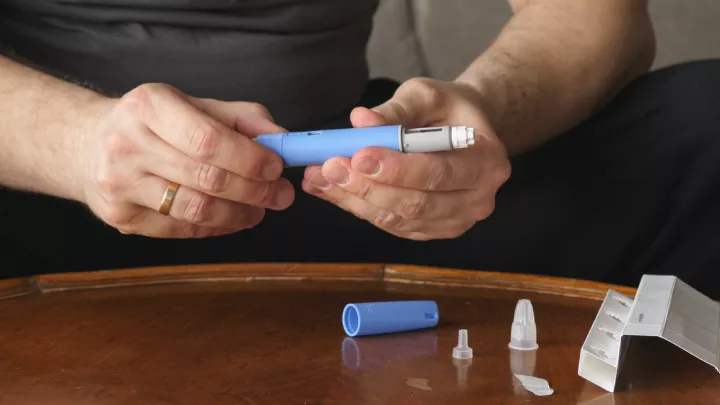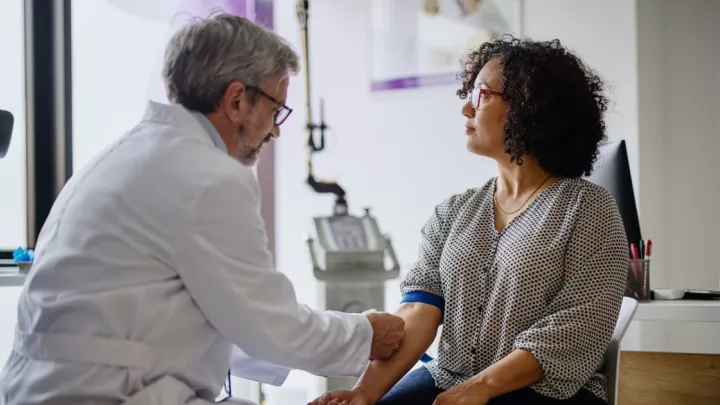Numbness or tingling in your hands? You might have degenerative cervical myelopathy

Degenerative cervical myelopathy is the leading cause of spinal cord impairment in adults, affecting nearly 1 in 10 individuals at some point in their lives. The condition arises from gradual, progressive compression of the spinal cord in the neck due to disc disease, unstable bone movement or ligament growth within the spinal canal. If left untreated, the natural history of the disease is increasing loss of dexterity and function in the hands, worsening balance and bladder function, and eventually quadriparesis. Once diagnosed, the recommended treatment is typically surgery, and early intervention is key to promoting recovery and maintaining quality of life. Read on to learn how to detect the early signs of DCM and explore possible treatment options.
Symptoms of DCM
Early signs of DCM include:
- Numbness and tingling in the hands and fingers.
- Dexterity issues or difficulty with fine motor skills, such as trouble buttoning a shirt, writing or sewing.
- Problems with walking and balance, especially on uneven ground.
- Radicular arm pain, or pain that radiates down the arm.
As the disease progresses, it can also lead to issues with bladder function.
DCM is often mistaken for other conditions, such as peripheral neuropathy or carpal tunnel syndrome, which are also very common. If there is any doubt, a prompt evaluation by a qualified spine specialist is recommended, especially for adults over the age of 50. Early diagnosis and treatment can help you avoid permanent damage and loss of function.
Causes of DCM
The following factors may increase your risk of developing DCM:
- Age – DCM is commonly diagnosed in patients over the age of 50, and it can be especially prevalent in those over age 70
- Gender – Males are three times more likely to develop DCM than women
- Tobacco smoking – Smoking significantly increases your risk of arthritis anywhere in the spine
- Injury or repeated trauma – Some individuals, such as elite athletes, can develop early onset arthritis in the cervical spine due to overuse or excessive forces
- Musculoskeletal conditions – Diseases that can affect bone metabolism and development, such as rheumatoid arthritis and ankylosing spondylitis, can accelerate changes in the neck that lead to DCM
- Ossification of the posterior longitudinal ligament – OPLL occurs when the ligament that connects and stabilizes the bones of the spinal column becomes thicker and less flexible, often due to hereditary or genetic factors
For some people, the onset of DCM is unavoidable. However, most people can take steps to reduce their risk later in life. These measures include:
- Staying active
- Maintaining a healthy BMI
- Avoiding smoking
- Controlling other medical problems
- Avoiding occupational hazards that can lead to overuse or neck injuries
“If you have DCM, you want to take yourself out of any environment that would put increased strain on your neck,” says Jamie Wilson, MD, FRCS, Nebraska Medicine neurosurgeon and DCM researcher. “Also, it’s important to avoid contact sports, roller coasters or horseback riding – anything that could result in sudden or extreme movements of your neck.”
DCM treatment options
The standard diagnostic tools to confirm whether someone has DCM is an MRI, along with a comprehensive examination. Patients with mild impairment can be monitored, and many can see improvement with nonoperative measures like physiotherapy. However, in most cases of moderate to severe impairment, surgery is recommended as the definitive treatment.
“Once a diagnosis of DCM has been made and you have reached a certain level of functional impairment, then there is only one treatment proven to be effective, and that is decompressive surgery,” says Dr. Wilson. “No other treatments or nonoperative measures have been proven to be successful, and if you delay treatment and get worse, the potential for recovery after surgery also gets worse.”
Decompressive surgery is performed to take pressure off the spinal cord, and in some cases, to reconstruct areas of additional weakness. This may include removing discs and placing a bone graft into the disc space to open it up, as well as correcting misalignment in the spine or reconstructing an area of the spine with titanium screws and rod implants. Most patients only need surgery once, but some may need additional surgery on untreated areas of the spine as they age.
“If you have any of the symptoms above, it’s important to seek medical advice and imaging promptly – if only for peace of mind – because the potential downside of untreated DCM can be devastating,” says Dr. Wilson. “I urge all adults – particularly those of retirement age or older – to be vigilant about these symptoms and to speak to a qualified medical professional if they have any concerns.”
For more information or to schedule an appointment with the Comprehensive Spine Program, call 800.922.0000.






